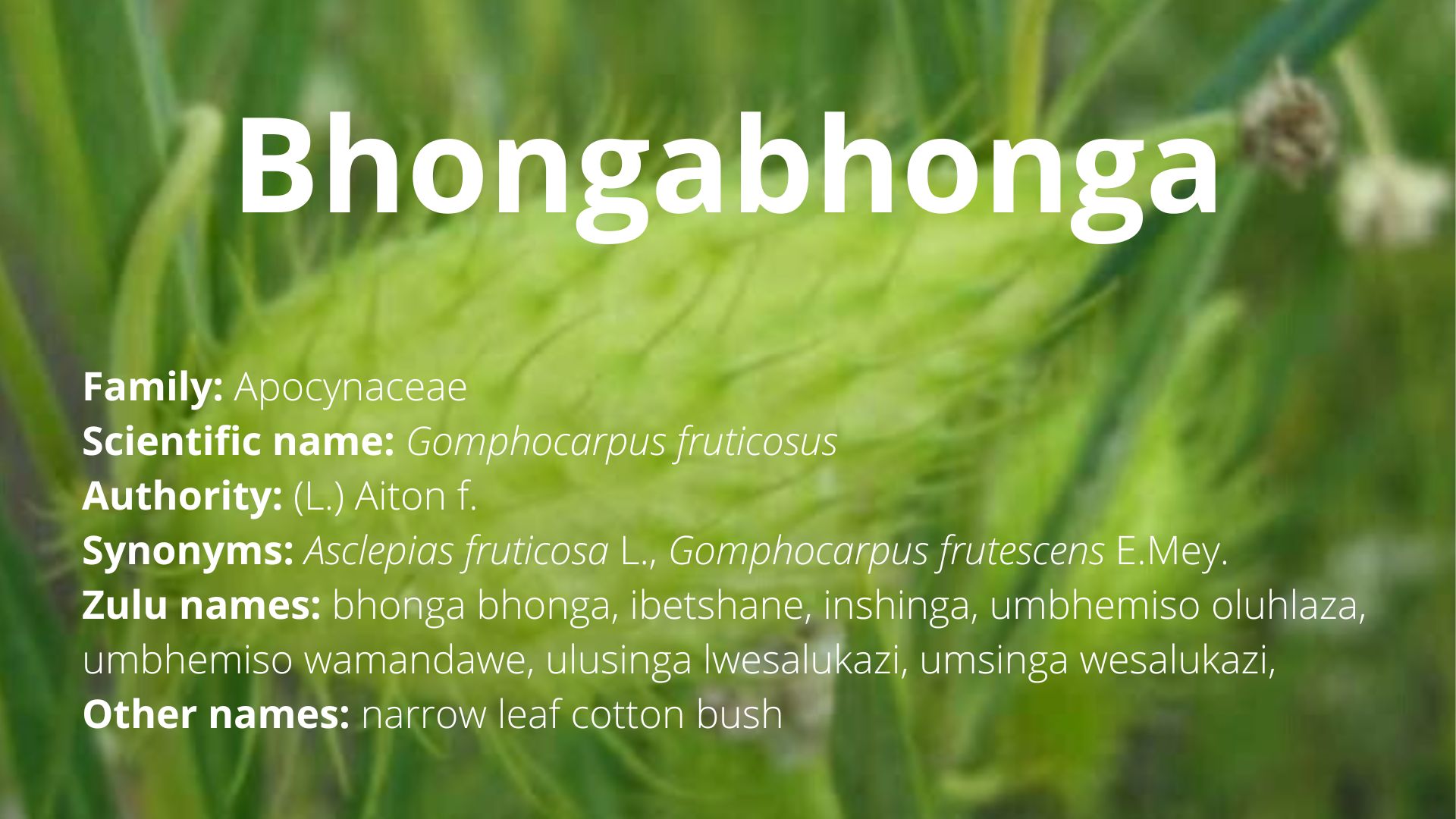Family: Apocynaceae
Scientific name: Gomphocarpus fruticosus
Authority: (L.) Aiton f.
Synonyms: Asclepias fruticosa L., Gomphocarpus frutescens E.Mey.
Zulu names: bhonga bhonga, ibetshane, inshinga, umbhemiso oluhlaza, umbhemiso wamandawe, ulusinga lwesalukazi, umsinga wesalukazi,
Other name: narrow leaf cotton bush
Description: G. fruticosus is an erect woody perennial shrub with a milky latex that grows to about 2 m in height. It is native to South Africa and has long narrow leaves with entire margins, cream to yellow flowers in dense clusters, and balloon-like fruits containing black seeds.
The plant contains toxic steroids (known as cardenolides) that, when consumed in large doses, can lead to death in humans and farm animals.
Uses:
- The leaves are dried and ground to fine powder and used as a snuff to treat headaches.
- The leaves are used to make a decoction that is put in the ear to treat earache.
- The leaves are used to make an infusion that is taken to treat stomach pain, a bulging stomach in children, and diarrhoea.
- The fruits and leaves are used to make a decoction mixed with fresh milk given to babies as enema to treat inyoni, a nervous disorder.
- The fruits are used to make a tonic given to children to treat flu.
- The latex in fruits is squeezed in the nostrils to treat asthma, bronchitis, chest ailments, colds, and flu.
- The roots are an ingredient in a mixture to make umuthi wamadoda, a tonic to treat virility.
- The roots are used to treat heart disorders, such as cardiac palpitations.
- The plant is used to treat inflammation, such as swelling and blisters on the pharynx.
- The plant is taken regularly during pregnancy to ensure easy childbirth.
- The plant is used to treat skin infections, such as itching and scabies.
- The plant is used as a diuretic.
- The leaves are used to make an infusion to induce vomiting in cases of hepatitis.
- The leaves are used to make a decoction to treat distemper in dogs.
- The plant is used to treat anthrax in cattle.
- The plant is used to dispel evil and to perform exorcism.
References and further reading:
- Amusan, O.G., Sukati, N.A., Dlamini, P.S., Sibandze, F.G., 2007. Some phytomedicines from Shiselweni region of Swaziland. Journal of Natural Remedies 5, pp.19–25.
- Baerts, M. and Lehmann, J., 2009. Gomphocarpus fruticosus. Prelude Medicinal Plants.
- Botha, C.J. and Venter, E., 2002. Gomphocarpus fruticosus.
- Burkill, H.M., 1985. The Useful Plants of West Tropical Africa, vol. 1., Farinhes A. D, Royal Botanical Gardens, Kew, pp.346-349.
- Gerstner, J., 1941. A Preliminary check list of Zulu names of plants. Bantu Studies.
- Hedberg, I.D and Staugard, F., 1989. Traditional medicinal plants: Traditional medicine in Botswana. Ipeleng, Gabarone.
- Hulme, M.M., 1954. Wild flowers of Natal. Shutter and Shooter, Pietermaritzburg.
- Long, C., 2005. SiSwati names and uses – Swaziland Flora – Swaziland National Trust Commission, Mbabane.
- Mothana, R.A., Al-Musayeib, N.M., Al-Ajmi, M.F., Cos, P. and Maes, L., 2014. Evaluation of the in vitro antiplasmodial, antileishmanial, and antitrypanosomal activity of medicinal plants used in Saudi and Yemeni traditional medicine. Evidence-Based Complementary and Alternative Medicine, 2014.
- Mulaudzi, RB, Ndhlala, AR and Van Staden, J., 2015. Ethnopharmacological evaluation of a traditional herbal remedy used to treat gonorrhoea in Limpopo province, South Africa. South African Journal of Botany , 97 , pp.117-122.
- Ndhlovu, P.T., Omotayo, A.O., Otang-Mbeng, W. and Aremu, A.O., 2021. Ethnobotanical review of plants used for the management and treatment of childhood diseases and well-being in South Africa. South African Journal of Botany, 137, pp.197-215.
- Pujol, J., 1990. Natur Africa: The herbalist handbook. Jean Pujol Natural Healers Foundation, Durban.
- Shabangu, T.P., 2021. A comparative study of Swazi and Zulu traditional plant use at Mkhondo and eDumbe, South Africa. University of Johannesburg (South Africa).
- Suroowan, S., Pynee, K.B. and Mahomoodally, M.F., 2019. A comprehensive review of ethnopharmacologically important medicinal plant species from Mauritius. South African Journal of Botany, 122, pp.189-213.
- Watt, M.J. and Breyer Brandwijk, M.G., 1962. Medicinal and poisonous plants of southern and eastern Africa. Livingstone, London.
